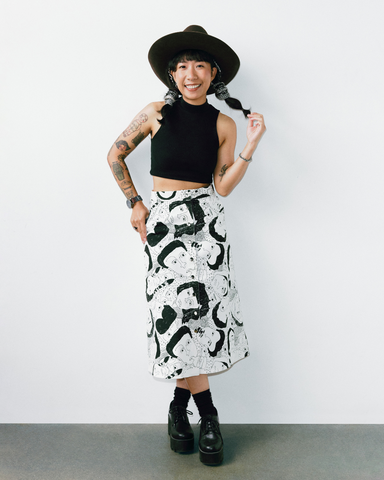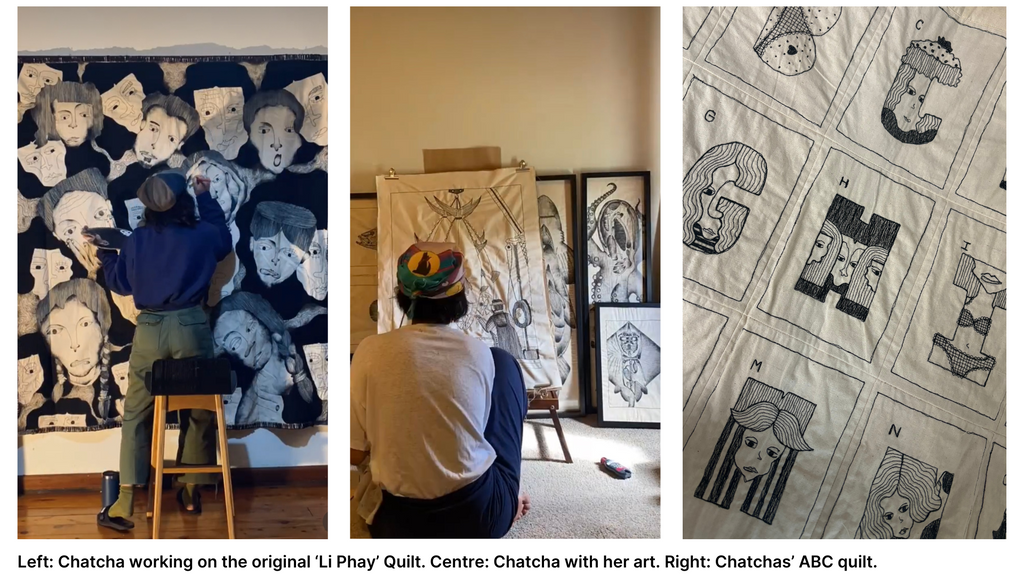FREE SHIPPING ON ORDERS OVER $250
Meet Chatcha, the Artist behind 'Li Phay' Faces of Refugees

Meet Chatcha
Chatcha is one of The Social Outfit's talented Sewing Technicians and Artist. She uses fabric which she machine stitches and paints to create incredible pieces of Art.
(Video by Weld Stories)

When we saw her work, the craftmanship and meaning behind her pieces, we had to explore the opportunity to develop her artwork into a print. The original 'Li Phay’ artwork, which depicts a series of refugee faces, is masterfully sewn and embroidered onto a quilt. lt was developed into a digital print by Chatcha and Sonya Price-Kelly in collaboration with The Social Outfit.
We sat down with Chatcha to find out more about her Art, background and the process behind developing the Li Phay Print:
Can you tell us about your background and how you got into Art?
I studied Fashion Design but I didn't do the sewing part, only design, and I thought to myself 'Why not do it yourself?' rather than pay someone to do all the sewing. Also, the clothes that I would buy were always too big and they always needed to be altered to fit me. I needed to do these alterations so it all made sense for me to learn the sewing part too. I went to a sewing trial, got the job and then thought I could use the sewing machine to draw. It was a friend's birthday so I thought I would sew his portrait as his gift and I loved it. That was in 2021.
We would love to know more about your style and techniques... The detailed stitch work and black ink are your signature, can you tell us more about it?
I started with just stitching as you can see from the ‘ABC’ quilt. A friend said that if I wanted to sell these then he was not going to buy them because it needs to be more interesting... so I thought why not paint as well to give more dimension. I normally just use black ink or maybe a little bit of colour, like one other colour. I took on my friends feedback as I want to keep evolving.

Moving onto the quilt. What techniques did you use?
I drew and outlined it first. Then moved onto stiching - machine stitched and then hand stitched and finally painted. I then used Raffia as the border but that was hard. My hands were sore. I saw a lady doing Raffia bags and just asked what is this and how do you do it as I wanted that detail for the boarder.
I believe it took you 7 months to complete and is of a larger scale compared to your other work...What was the inspiration behind your quilt and why the subject of Refugees?
I always do faces or characters of some sort. Often you see it's my face. But, I always wanted to do something about refugees… I saw the Rohingya boat…where a group of people came from a boat. I wanted to draw something inspired by that. And looked for inspiration. This was all before I worked with the Social Outfit.
Can you tell us more about the process from quilt to print? (Answered by Sonya Price-Kelly, who worked with Chatcha directly to develop the Digital Print. Sonya and Chatcha developed the print together, spending 2 days working on it where Sonya shared her knowledge and upskilled Chatcha on the process of developing a digital print, in particular, one for repeat).
We initially consulted with Publisher Textiles early on. We loved the design and thought it would work great as a screen print. We took the quilt to Publisher so they could let us know if it was feasible. We were directed and given technical feedback regarding line weight etc so we could best translate the quilt stitching to the digital print.

With this information in mind, together we photographed the faces, scanned and imported them onto an iPad so Chatcha could manipulate them into a digital print. We settled on the reverse side of the print that had more stitch work and details that would best translate to the digital print.
I showed Chatcha how to create a print for repeat, as we knew we wanted to screen print it so we worked on creating a tile that could be moved and repeated. The print has a slightly different placement to the quilt but Chatcha reconfigured the faces and manipulated the design until she was happy with it.
We then went back to photograph the stitches and detail elements that were then used to fill in the gaps between the faces. We occasionally dropped more details like the eye. The final print files were sent to Publisher Textiles where our tile was made.
What was it like seeing the garments come to life and working with your print in the workroom?
It was so exciting when the first roll arrived! So exciting seeing Chatcha and The Social Outfit on the fabric. Lily Rose (our cutter in our workroom) asked me if it was my print and I was like YES! When she was cutting the fabric for the first skirt, she asked if I wanted to keep an off cut with my name printed on it and I did.
What now for Chatcha and your Art?
Working on it this year. I am working on a 16-piece collection and applying for different gallery spaces. I have also signed up for my first market in May and I hope to start selling then.
